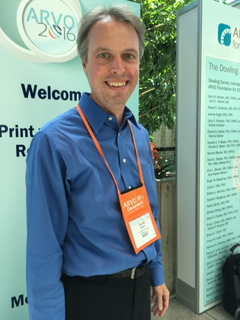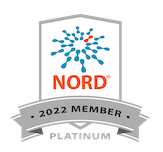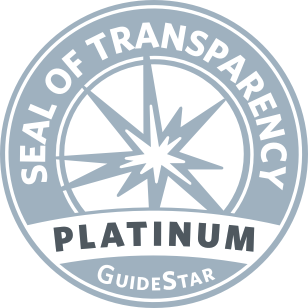ARVO 2016: Emerging Drug Targets Toxic Build-Up in Stargardt Disease
Eye On the Cure Research News
In August 2015, the biotech company Alkeus launched a multi-center TEASE Phase II clinical trial for the drug ALK-001.

Dr. Hendrik Scholl, TEASE’s coordinating investigator and principal investigator at Johns Hopkins School of Medicine, at ARVO 2016.
Like many diseases affecting the macula, the center of the retina, Stargardt disease is a waste-management problem. The "garbage" comes from the processing of vitamin A, which is an essential nutrient for vision. If you think of the retina as the engine for vision, vitamin A is the fuel; it enables the retina to convert light into the electrical signals that enable vision. And just like gasoline, which produces exhaust, vitamin A, when metabolized, leads to undesirable by-products.
People with Stargardt disease have a vitamin-A recycling defect leading to the build-up of waste products. Research suggests that the accumulated damage over time from toxins leads, ultimately, to loss of photoreceptors and vision. Unfortunately, in Stargardt disease, the problem is most pronounced in the macula, which is responsible for central vision. People with the condition usually have a progressively expanding blind spot, making it difficult to read, drive and recognize faces.
In August 2015, the biotech company Alkeus launched a multi-center TEASE Phase II clinical trial for the drug ALK-001, which targets this waste-management problem. The emerging therapy is a modified form of vitamin A, which, when metabolized in the retina, results in much less waste. Scientists developed ALK-001 by replacing hydrogen atoms in vitamin A with deuterium. Known as deuterated vitamin A, it "burns cleaner" than the natural form. Deuterium is a safe, naturally occurring, non-radioactive form of hydrogen which is present in the human body.
Several large pharmaceutical companies are adding the deuterium atom to drug candidates with the hopes of improving safety and/or duration of efficacy. For example, Teva Pharmaceuticals is seeking approval from the U.S. Food and Drug Administration for deutetrabenazine, a drug targeting tardive dyskinesia, an involuntary-movement disorder.
Hendrik Scholl, M.D., TEASE's coordinating investigator and principal investigator at Johns Hopkins School of Medicine, presented a poster describing the ALK-001 project on May 2 at the annual meeting of the Association for Research in Vision and Ophthalmology (ARVO) which is attended by 12,000 eye and retina experts from around the world. He discussed the drug's mechanism of action, the design of the 50-participant, two-year clinical trial and initial safety data.
Thus far, animal studies have shown that ALK-001 prevents the formation and accumulation of toxins, and vision loss, in mice affected with Stargardt disease. A four-week, Phase I safety-only study in people was successful; no adverse events, toxicity or side effects were reported.
"The Phase II study will hopefully tell us more about the drug's potential for slowing vision loss in people with Stargardt disease," says Dr. Scholl. "If it works, we may have an opportunity to try it for other macular conditions, including dry age-related macular degeneration, a leading cause of blindness in the United States and Europe. In all of these macular diseases, toxins from vitamin A-processing are thought to be contributing to the degeneration. It would be great to have a single option that can address many of them."




